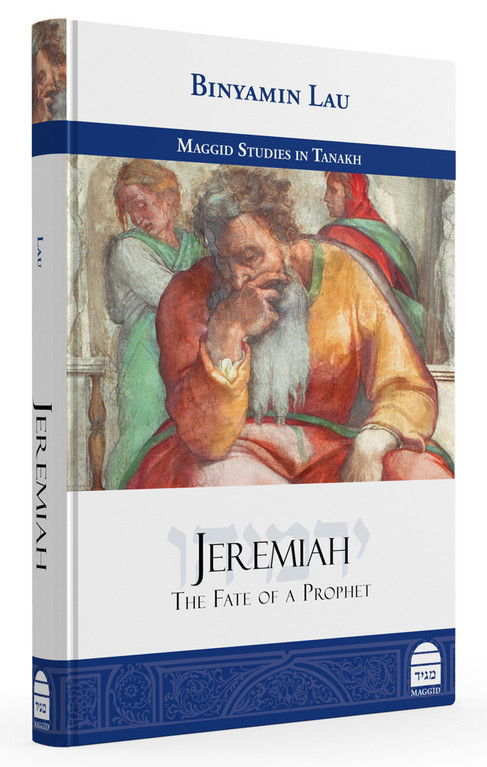For Tisha B’Av, a book about Jeremiah, prophet of doom
With the upcoming Fast of Tisha B’Av, it is appropriate to note the recent publication of a biography and historical analysis of one of the great prophets of our faith, Jeremiah, whose teachings are the featured prophetic readings that morning and whose scroll, Eichah (Lamentations) is the centerpiece reading the previous evening at the start of the fast.
Entitled, “Jeremiah: The Fate of a Prophet” [Maggid Books 2013] by Rabbi Dr. Binyamin Lau, this 225 page work goes into great analytical detail in its interpretation of Jeremiah’s message of doom and gloom admonitions to his people.
In detailing chapter eight, the selection read on the fast itself, Rabbi Lau quotes from the work, “Path of the Just” by Rabbi Moshe Chaim Luzzatto:
“Jeremiah laments the evil of his contemporaries, for whom this defect is like a plague. They turn a blind eye to their own actions, without taking heed to determine whether they should be engaged in or abandoned. He says about these men, ‘No one regrets his wrongdoing. … Each pursues his course like a horse charging into battle.’ He means that they act out of impulse and habit, without leaving themselves time to evaluate their actions and ways, and, as a result, fall into evil without noticing.”
This observation by Rabbi Luzzatto is a most fitting teaching as applied by Rabbi Lau to this reading from Jeremiah. I am surprised that no one till now, to my knowledge, has previously applied this to this prophetic verse.
The pathos and sadness that one feels in the prophet’s voice fills this entire work. These were bad times, times permeated with willful sin, a faith ignored and a life style of greed that ridiculed all divine teaching.
Rabbi Lau tells us the following:
“Despair floods Jeremiah, and he is overcome with a prophecy that in time will become a hymn of destruction, read on the most tragic day of the Jewish calendar, Tisha B’Av: ‘I will surely consume them — declares the L-rd.’ This vision spills out of him with terrible pain. He begs to escape the role that has been forced upon him, that of the prophet of doom.
“In his mind’s eye, he sees the fruit trees of the Land of Israel – the emblematic grapevine and the fig tree – fruitless. There is nothing to hope for; the enemy will arrive and devour all who inhabit this land.”
The prophet is conflicted between two sentiments, that is, he is torn between wounded love and rising anger, according to Rabbi Lau. That is the bottom line message that we come to learn from the prophet. “In today’s world, Jeremiah is perceived as the prophet of the Temple’s destruction, the composer of our Tisha B’Av Lamentations. The modern word ‘jeremiad,’ meaning a work that mourns society and its imminent downfall, reinforces this perception.”
If you are not familiar with the life and times of Jeremiah, this would be one work for you to explore as part of your Nine Days regimen. It will teach you history with feeling and, hopefully, reorient you as you enter the fast and experience further its message.
Rabbi Lau directs the Center for Judaism and Society at Beit Morasha of Jerusalem and serves as rabbi at the Ramban Synagogue. He was also a founder of the Moshe Green Beit Midrash for Women and is a lecturer on halacha and social justice at Beren College.
Rabbi Lau studied at Yeshivat Har Etzion and earned his Ph.D in Talmud at Bar Ilan University. His previous literary work was the much acclaimed three-volume “The Sages: Character, Context and Creativity.”
For further study
For your edification, you might want to explore further the Jeremiah legacy by reading the following essays [available online from vbm-torah.org] :
“Yirmiyahu and Moshe – Two Models of Prophecy,” by Rabbi Moshe Lichtenstein
“Complementary Reproaches — The difference between Yirmiyahu and Yeshayahu,” by Rabbi Moshe Lichtenstein
“The Oral Law and the Secret of ‘Eicha’,” by Rabbi Yaakov Medan
Also recommended are two of the best commentaries on the haftarot,
“The JPS Bible Commentary: Haftarot,” by Dr. Michael Fishbane, which includes an extensive commentary and biography on Jeremiah.
Also, a newly published commentary on Isaiah was recently issued by Artscroll. Especially noteworthy for your immediate attention is their commentary on the Yeshayahu texted haftarot timed to this time of year until Rosh Hashanah. This work, with a most valuable introduction by Rabbi Nosson Scherman, deserves your study for the balance of the summer. Taken together with Dr. Fishbane’s work, these two works will help you better understand the historic as well as text content of our haftarah readings throughout the year.

 55.0°,
Mostly Cloudy
55.0°,
Mostly Cloudy 







